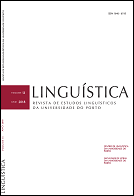Relativas livres e interrogativas parciais: como Óscar Lopes viu algumas destas construções
Resumo
Neste artigo analisamos alguns aspetos sintáticos e semânticos das relativas livres e das interrogativas subordinadas parciais próprias e impróprias, desenvolvendo Brito (1991), Brito & Duarte (2003), Móia (1996), Veloso (2013), Matos & Brito (2013), Mioto & Lobo (2016), correlacionando-os com a forma como Óscar Lopes descreveu estas construções e destacando a ambiguidade estrutural e semântica de algumas delas. Defendemos a existência de diversos tipos de relativas livres com leitura definida, com leitura universal e com leitura indefinida.
Referências
Alexandre, N. 2012. The Defective Copy Theory of Movement: Evidence from Wh-Constructions in Cape Verdean Creole, Amsterdam / Philadelphia: John Benjamins. http://benjamins.com/#catalog/books/cll.41/main
Adger, D. & J. Quer. 2001. The syntax and semantics of unselected embedded questions, Language, 77(1): 107-133.
Brito, A. M. 1991. A sintaxe das orações relativas em Português. Estrutura, mecanismos interpretativos e condições sobre a distribuição dos morfemas relativos. Instituto Nacional de Investigação Científica. Centro de Linguística da Universidade do Porto. Porto.
Brito, A. M. & Duarte, I. 2003. Orações relativas e construções aparentadas. In Mateus, M. H. et al. 2003.Gramática da Língua Portuguesa, 6ª ed., Lisboa: Caminho, 675 – 684.
Cardoso, A. 2017. Portuguese Relative Clauses in Synchrony and Diachrony. Oxford: Oxford University Press.
Cardoso, A. & Alexandre, N. 2013. Relativas clivadas em variedades não standard do português europeu. In F. Silva; I. Falé & I. Pereira (orgs.). Textos Selecionados do XVIII ENAPL, 2012, Porto: APL, 205-227.
Chomsky, N. 1973.Conditions on Transformations. In S. Anderson & P. Kiparsky (eds.), A Festschrift for Morris Halle. New York: Holt Rinehart and Winston, 232-286.
Chomsky, N. 1977. On Wh-Movement. In P. W. Culicover, T. Wasow & A. Akmajian (eds.), Formal Syntax. New York: Academic Press, 71-132.
Grosu, A. & Landman, F. 1998. Strange Relatives of the Third Kind. Natural Language Semantics (6) : 125 170.
Grosu, A. 2000. Type resolution in relative constructions. Feature marking and dependency encoding. In Alexiadou, A., Law, P., Meinunger, A. & Wilder, C. 2000 (eds.), The Syntax of Relative Clauses. Amsterdam: John Benjamins, 83-120.
Haegeman, L. 2012. Adverbial Clauses, Main Clause Phenomena, and the Composition of the Left Periphery. Oxford: Oxford University Press.
Hinzen, W. & Sheehan, M. 2011 Moving towards the edge: the grammar of reference, Linguistic Analysis 37,405-458.
Huang, C. T. J. 1982. Logical relations in Chinese and the theory of grammar. PhD dissertation, MIT.
Jacobson, P. 1995. On the Quantificational Force of English Free Relatives. In E. Bach, E. Jelinek, A. Kratzer & B. Partee (eds.) Quantification in Natural Languages. Dordrecht: Kluwer, 451-486.
Karttunen, L. 1977. Syntax and Semantics of Questions. Linguistics and Philosophy 1: 3-44.
Kato, M. 2013. Deriving “wh-in-situ” through movement in Brazilian Portuguese. In V. Camacho-Aboada, A. Jimenéz-Fernández, Martín-J. Gonzáles, & M. Reyes-Tejedor (eds.) Information Structure and Agreement, Amsterdam: John Benjamins, 175-191.
Lahiri, Utpal. 2002. Questions and Answers in Embedded Contexts, Oxford: Oxford University Press.
Lecarme, J. 2008. Tense and modality in nominals. In Jacqueline Guéron & Jacqueline Lecarme (eds.), Time and modality. Dordrecht: Springer, 195–225.
Lopes, Ó. 1971. Gramática Simbólica do Português, Lisboa, Fundação Calouste Gulbenkian, 1ª edição.
Matos, G. & Brito, A. M. 2013. The alternation between improper indirect questions and DPs containing a restrictive relative. In V. Camacho-Aboada, A. Jimenéz-Fernández, Martín-J. Gonzáles & M. Reyes-Tejedor (eds.) Information Structure and Agreement, Amsterdam: John Benjamins, 83-116.
Matos, G. & Brito, A.M. 2018. Relativas livres e interrogativas parciais: paralelos e diferenças, Revista da Associação Portuguesa de Linguística, Nº 4 – 09 / 2018 | 152- 167 | https://doi.org/10.26334/2183-9077/rapln4ano2018a38
Mioto, C. & Lobo, M. 2016. Wh movement: interrogatives, relatives and clefts. In W. L. Wetzels, S. Menuzzi & J. Costa (eds.) The Handbook of Portuguese Linguistics. Wiley-Blackwell, 275-293.
Móia, T. 1996. A sintaxe das orações relativas sem antecedente expresso do Português. In Gonçalves, A. & Colaço, M. & Miguel, M. & Móia, T. 1996. Quatro estudos em sintaxe do Português. Uma abordagem segundo a teoria dos princípios e parâmetros. Lisboa: Edições Colibri,149-188.
Plann, S. 1982. Indirect Questions in Spanish, Linguistic Inquiry, 12: 297-312.
Reuland, E. & ter Meulen, A. 1987 Introduction. In Reuland, E. & ter Meulen, A. (eds.)
The representation of (In)definiteness, Cambridge, MA: The MIT Press, 1-20.
Riemsdijk, H. 2007. Free Relatives. In Everaert, M. & van Riemsdijk, H. (eds.) The Blackwell Companion to Syntax, Blackwell, 338-382.
Rinke, E. & Assmann, E. 2017.The Syntax of Relative Clauses in European Portuguese. Extending the Determiner Hypothesis of Relativizers to Relative que. Journal of Portuguese Linguistics, 16 (4): 1–26. DOI: https://doi.org/10.5334/jpl.172
Rivero, M. L. 1994. On indirect questions, commands and the Spanish quotative que. Linguistic Inquiry 25: 547-55.
Rudin, C. 1988. On multiple questions and multiple wh-fronting. Natural Language and Linguistic Theory 6: 445-501.
Said Ali, M. 1931 Gramática Histórica da língua Portuguesa. São Paulo: Edições. Melhoramentos, 1964.
Stoyanova, M. 2008. Unique focus: languages without multiple wh-questions. Amsterdam/Philadelphia: John Benjamins.
Suñer, M. 1991. Indirect Questions and the structure of CP: Some consequences. In H. Campus & F. Martínez-Gil (eds.) Studies in Romance Linguistics. Dordrecht, Foris Publications, 183-203.
Suñer, M. 1993. About indirect questions and semi-questions. Linguistics and Philosophy, 16: 45-77.
Suñer, M. 1999. La subordinación sustantiva: la interrogación indirecta. In I. Bosque & V. Demonte (eds.) Gramática Descritiva de la LenguaEspañola. Madrid: Espasa, 2147-2195.
Veloso, R. 2013. Subordinação relativa. In Raposo, E., F. Nascimento, M.A. Mota, L. Segura & A. Mendes. 2013. Gramática do Português. Lisboa: Fundação Calouste Gulbenkian, Vol. II: 2061 – 2134.
Downloads
Publicado
Edição
Secção
Licença
Direitos de Autor (c) 2019 Linguística: Revista de Estudos Linguísticos da Universidade do Porto

Este trabalho encontra-se publicado com a Creative Commons Atribuição-NãoComercial 4.0.



